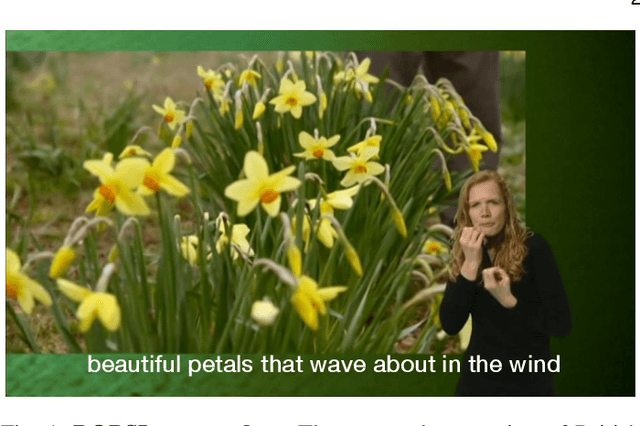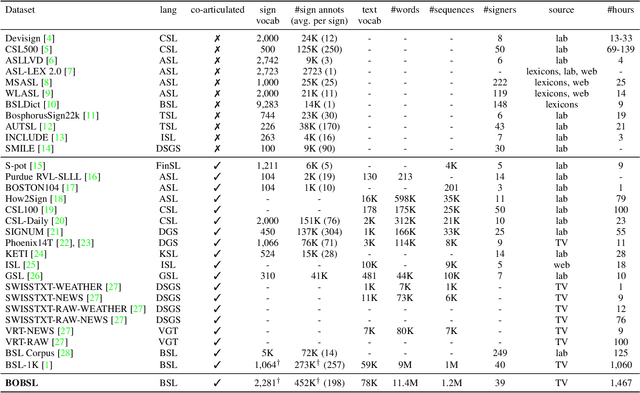Bencie Woll
SLRTP2025 Sign Language Production Challenge: Methodology, Results, and Future Work
Aug 09, 2025Abstract:Sign Language Production (SLP) is the task of generating sign language video from spoken language inputs. The field has seen a range of innovations over the last few years, with the introduction of deep learning-based approaches providing significant improvements in the realism and naturalness of generated outputs. However, the lack of standardized evaluation metrics for SLP approaches hampers meaningful comparisons across different systems. To address this, we introduce the first Sign Language Production Challenge, held as part of the third SLRTP Workshop at CVPR 2025. The competition's aims are to evaluate architectures that translate from spoken language sentences to a sequence of skeleton poses, known as Text-to-Pose (T2P) translation, over a range of metrics. For our evaluation data, we use the RWTH-PHOENIX-Weather-2014T dataset, a German Sign Language - Deutsche Gebardensprache (DGS) weather broadcast dataset. In addition, we curate a custom hidden test set from a similar domain of discourse. This paper presents the challenge design and the winning methodologies. The challenge attracted 33 participants who submitted 231 solutions, with the top-performing team achieving BLEU-1 scores of 31.40 and DTW-MJE of 0.0574. The winning approach utilized a retrieval-based framework and a pre-trained language model. As part of the workshop, we release a standardized evaluation network, including high-quality skeleton extraction-based keypoints establishing a consistent baseline for the SLP field, which will enable future researchers to compare their work against a broader range of methods.
BBC-Oxford British Sign Language Dataset
Nov 05, 2021



Abstract:In this work, we introduce the BBC-Oxford British Sign Language (BOBSL) dataset, a large-scale video collection of British Sign Language (BSL). BOBSL is an extended and publicly released dataset based on the BSL-1K dataset introduced in previous work. We describe the motivation for the dataset, together with statistics and available annotations. We conduct experiments to provide baselines for the tasks of sign recognition, sign language alignment, and sign language translation. Finally, we describe several strengths and limitations of the data from the perspectives of machine learning and linguistics, note sources of bias present in the dataset, and discuss potential applications of BOBSL in the context of sign language technology. The dataset is available at https://www.robots.ox.ac.uk/~vgg/data/bobsl/.
A Multi-modal Machine Learning Approach and Toolkit to Automate Recognition of Early Stages of Dementia among British Sign Language Users
Oct 01, 2020



Abstract:The ageing population trend is correlated with an increased prevalence of acquired cognitive impairments such as dementia. Although there is no cure for dementia, a timely diagnosis helps in obtaining necessary support and appropriate medication. Researchers are working urgently to develop effective technological tools that can help doctors undertake early identification of cognitive disorder. In particular, screening for dementia in ageing Deaf signers of British Sign Language (BSL) poses additional challenges as the diagnostic process is bound up with conditions such as quality and availability of interpreters, as well as appropriate questionnaires and cognitive tests. On the other hand, deep learning based approaches for image and video analysis and understanding are promising, particularly the adoption of Convolutional Neural Network (CNN), which require large amounts of training data. In this paper, however, we demonstrate novelty in the following way: a) a multi-modal machine learning based automatic recognition toolkit for early stages of dementia among BSL users in that features from several parts of the body contributing to the sign envelope, e.g., hand-arm movements and facial expressions, are combined, b) universality in that it is possible to apply our technique to users of any sign language, since it is language independent, c) given the trade-off between complexity and accuracy of machine learning (ML) prediction models as well as the limited amount of training and testing data being available, we show that our approach is not over-fitted and has the potential to scale up.
 Add to Chrome
Add to Chrome Add to Firefox
Add to Firefox Add to Edge
Add to Edge